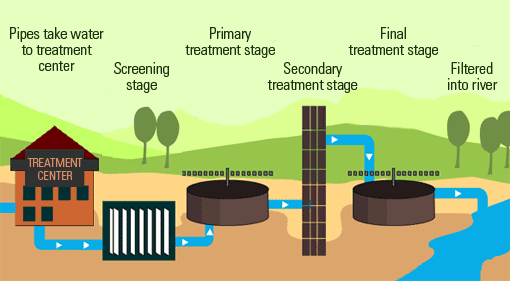Affordable Solutions for Large-Scale Waste Water Treatment Facilities
Affordable Solutions for Large-Scale Waste Water Treatment Facilities
Blog Article
Strategic Approaches to Improve Drainage Treatment Effectiveness and Decrease Environmental Effect
In the world of waste water therapy, the mission for improved effectiveness and minimized ecological effect is a continuous difficulty that requires tactical options. As culture grapples with the important to take care of water resources sustainably, a nuanced approach becomes crucial. The integration of sophisticated therapy modern technologies, energy-efficient processes, source recuperation techniques, boosted nutrient removal strategies, and smart tracking and control systems represents a diverse structure for attending to these pushing problems. Nevertheless, what lies at the core of this facility web of strategies is the possible to change the means we approach drainage treatment, not just as a process of disposal, yet as an important chance for advancement and environmental stewardship.
Advanced Therapy Technologies
Cutting-edge membrane purification systems have transformed advanced wastewater treatment procedures, dramatically enhancing the removal of impurities. This technology has proven to be very effective in eliminating a vast variety of contaminants, including drugs, hefty steels, and organic substances, which are often testing to get rid of with conventional treatment techniques.
In addition, membrane layer filtration systems offer countless advantages over standard treatment techniques. They require much less space, generate higher-quality effluent, and are extra immune to changes in influent water top quality. In addition, these systems are highly flexible and can be easily incorporated right into existing treatment plants or used as standalone units for decentralized applications. As the demand for tidy water remains to increase, the fostering of innovative membrane layer purification innovations is important to make sure efficient and sustainable wastewater therapy methods.
Energy-Efficient Procedures
The combination of energy-efficient processes in wastewater therapy systems is vital for optimizing resource use and reducing operational expenses. One key approach to boosting power performance in wastewater therapy is the usage of sophisticated oygenation systems, such as fine bubble diffusers or surface area aerators, which can improve oxygen transfer performance and decrease power usage.
In addition, enhancing process control and automation via making use of innovative sensing units and keeping track of systems can improve general power performance by changing procedures in real-time based upon actual need and conditions. Implementing power audits and frequently checking power efficiency indicators are necessary techniques to recognize areas for enhancement and track energy-saving initiatives efficiently. Generally, the fostering of energy-efficient procedures in wastewater treatment not just profits the atmosphere however additionally adds to long-term cost financial savings and functional sustainability.
Resource Healing Strategies
With a concentrate on optimizing resource use and sustainability in wastewater treatment systems, the execution of source recuperation techniques becomes a pivotal aspect in boosting functional efficiency. Resource recovery approaches in wastewater therapy involve the recognition and extraction of useful resources from the waste stream, therefore transforming what was as soon as considered waste into a useful asset. By implementing source recuperation strategies such as nutrient removal and healing, power generation from organic issue, and the production of recyclable water, wastewater treatment plants can decrease ecological impact while making best use of effectiveness.

Boosted Nutrient Elimination Techniques
Carrying out sophisticated nutrient elimination techniques is necessary for enhancing the effectiveness of wastewater treatment systems. Enhanced nutrient removal plays a crucial duty in lessening the environmental influence of cured effluent discharged into water bodies. One of the key techniques made use of for enhanced nutrient removal is the procedure of biological nutrient removal (BNR), which involves the elimination of nitrogen and phosphorus via organic processes. This can be achieved via using specialized microorganisms that can convert nitrogen compounds into inert nitrogen gas via denitrification, and collect phosphorus within their cells with a process called boosted biological phosphorus removal (EBPR)

In enhancement to BNR, progressed therapy methods such as membrane layer bioreactors (MBRs) and built wetlands can additionally be used to enhance nutrient removal efficiency. By incorporating these innovative nutrient elimination methods right into wastewater treatment markets, systems and towns can properly reduce nutrient contamination and protect the environment.
Smart Surveillance and Control Equipment
Using cutting-edge innovation, the combination of smart surveillance and control systems revolutionizes the functional efficiency of wastewater treatment facilities. These systems incorporate sophisticated sensors and information analytics to continually keep an eye on crucial specifications such as pH degrees, turbidity, dissolved oxygen, and circulation rates in real-time. By accumulating and analyzing this information, drivers can gain useful understandings into the performance of the therapy procedures, enabling proactive adjustments to enhance treatment performance.
Smart monitoring and control systems likewise sustain remote monitoring abilities, permitting drivers to accessibility real-time data and control functions from off-site places. This remote availability boosts operational adaptability and responsiveness, making it possible for quick treatments in instance of system breakdowns or variations in influent high quality. Furthermore, the predictive upkeep abilities of these systems aid protect against devices failures and lessen downtime, eventually enhancing the general integrity of wastewater treatment operations (Waste Water Treatment).
Verdict
To conclude, strategic techniques such as advanced therapy innovations, energy-efficient procedures, resource recuperation techniques, improved nutrient removal methods, and smart tracking and control systems play a critical function in enhancing wastewater therapy performance and decreasing ecological impact. By executing these techniques, wastewater therapy plants can boost their overall efficiency, minimize power intake, recover useful resources, and make certain compliance with environmental policies. These strategies are important for efficient you can try this out and lasting wastewater administration practices.

In conclusion, calculated click site methods such as sophisticated therapy modern technologies, energy-efficient procedures, resource healing methods, enhanced nutrient removal strategies, and clever monitoring and control systems play an important role in enhancing wastewater treatment effectiveness and minimizing ecological impact.
Report this page